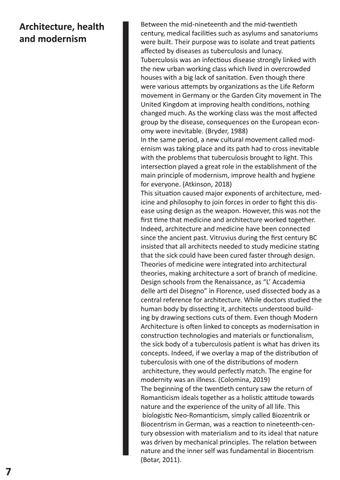Architecture, health and modernism
7
Between the mid-nineteenth and the mid-twentieth century, medical facilities such as asylums and sanatoriums were built. Their purpose was to isolate and treat patients affected by diseases as tuberculosis and lunacy. Tuberculosis was an infectious disease strongly linked with the new urban working class which lived in overcrowded houses with a big lack of sanitation. Even though there were various attempts by organizations as the Life Reform movement in Germany or the Garden City movement in The United Kingdom at improving health conditions, nothing changed much. As the working class was the most affected group by the disease, consequences on the European economy were inevitable. (Bryder, 1988) In the same period, a new cultural movement called modernism was taking place and its path had to cross inevitable with the problems that tuberculosis brought to light. This intersection played a great role in the establishment of the main principle of modernism, improve health and hygiene for everyone. (Atkinson, 2018) This situation caused major exponents of architecture, medicine and philosophy to join forces in order to fight this disease using design as the weapon. However, this was not the first time that medicine and architecture worked together. Indeed, architecture and medicine have been connected since the ancient past. Vitruvius during the first century BC insisted that all architects needed to study medicine stating that the sick could have been cured faster through design. Theories of medicine were integrated into architectural theories, making architecture a sort of branch of medicine. Design schools from the Renaissance, as “L’ Accademia delle arti del Disegno” in Florence, used dissected body as a central reference for architecture. While doctors studied the human body by dissecting it, architects understood building by drawing sections cuts of them. Even though Modern Architecture is often linked to concepts as modernisation in construction technologies and materials or functionalism, the sick body of a tuberculosis patient is what has driven its concepts. Indeed, if we overlay a map of the distribution of tuberculosis with one of the distributions of modern architecture, they would perfectly match. The engine for modernity was an illness. (Colomina, 2019) The beginning of the twentieth century saw the return of Romanticism ideals together as a holistic attitude towards nature and the experience of the unity of all life. This biologistic Neo-Romanticism, simply called Biozentrik or Biocentrism in German, was a reaction to nineteenth-century obsession with materialism and to its ideal that nature was driven by mechanical principles. The relation between nature and the inner self was fundamental in Biocentrism (Botar, 2011).




